Aviation Safety and Pilot Performance: Workload and Stressors Analysis
VerifiedAdded on 2023/04/20
|13
|3473
|417
Report
AI Summary
This report delves into the critical issues of workload and stressors within the aviation industry. It begins with an introduction that highlights the significance of these factors and proceeds to an extensive literature review, drawing on various research articles to explore their impact. The review covers topics such as techno-stress, cognitive pressure, and environmental stressors, and their effects on pilot fatigue, decision-making, and overall performance. The report also examines the role of workload and stressors in aviation accidents, as well as the importance of managing these factors to improve safety. The document concludes with a brief overview of the Swiss cheese model, offering a systems-based perspective on the accumulation of errors. The analysis emphasizes the complex interplay of factors that influence pilot performance and the broader implications for aviation safety. The report aims to provide a comprehensive overview of the current understanding of workload and stressors in aviation, and their impact on pilot performance.
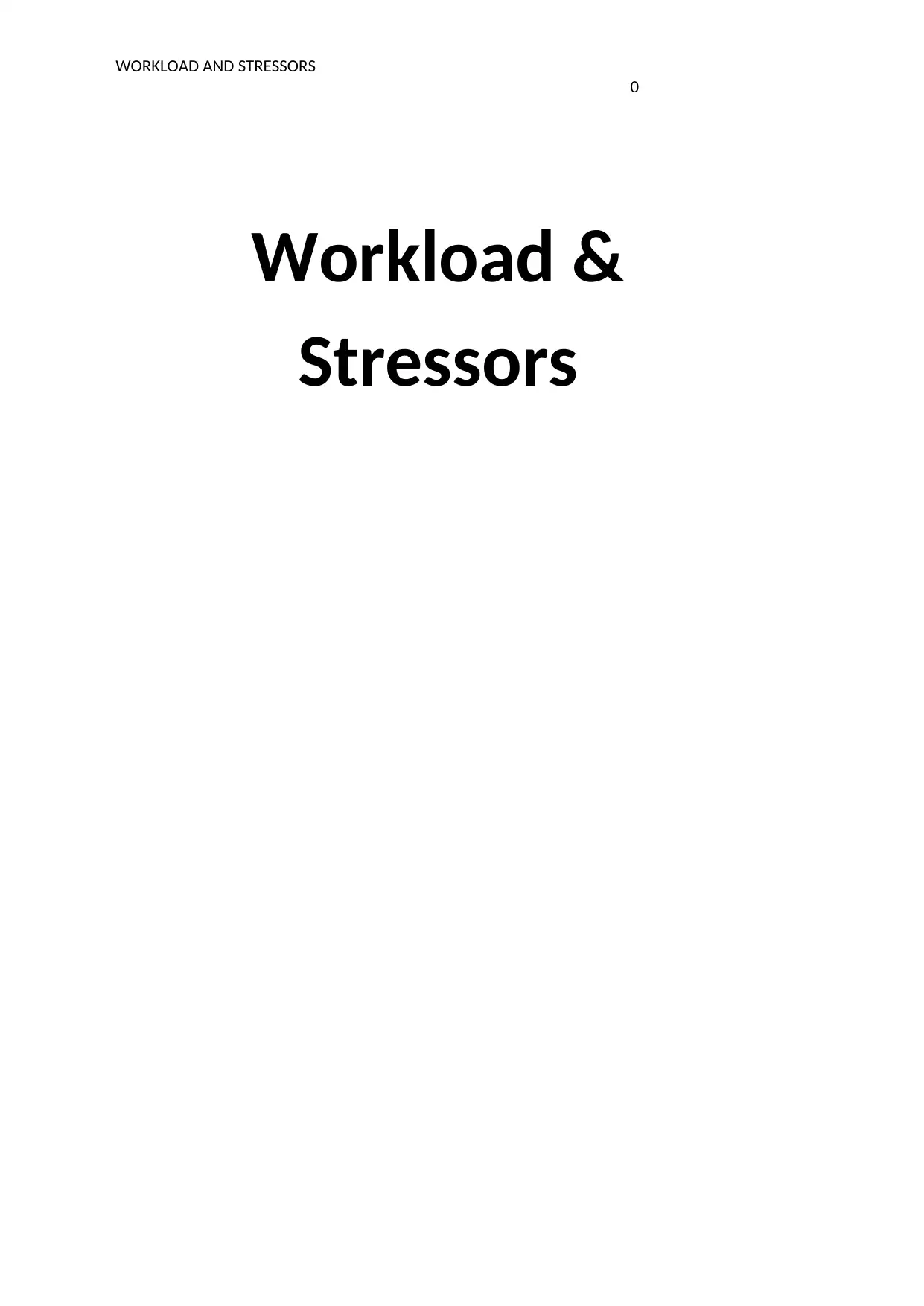
WORKLOAD AND STRESSORS
0
Workload &
Stressors
0
Workload &
Stressors
Paraphrase This Document
Need a fresh take? Get an instant paraphrase of this document with our AI Paraphraser

WORKLOAD AND STRESSORS
1
Table of Contents
Introduction...........................................................................................................................................2
Literature review...............................................................................................................................2
Swiss cheese model...........................................................................................................................8
Concluding statement...........................................................................................................................9
References...........................................................................................................................................10
1
Table of Contents
Introduction...........................................................................................................................................2
Literature review...............................................................................................................................2
Swiss cheese model...........................................................................................................................8
Concluding statement...........................................................................................................................9
References...........................................................................................................................................10
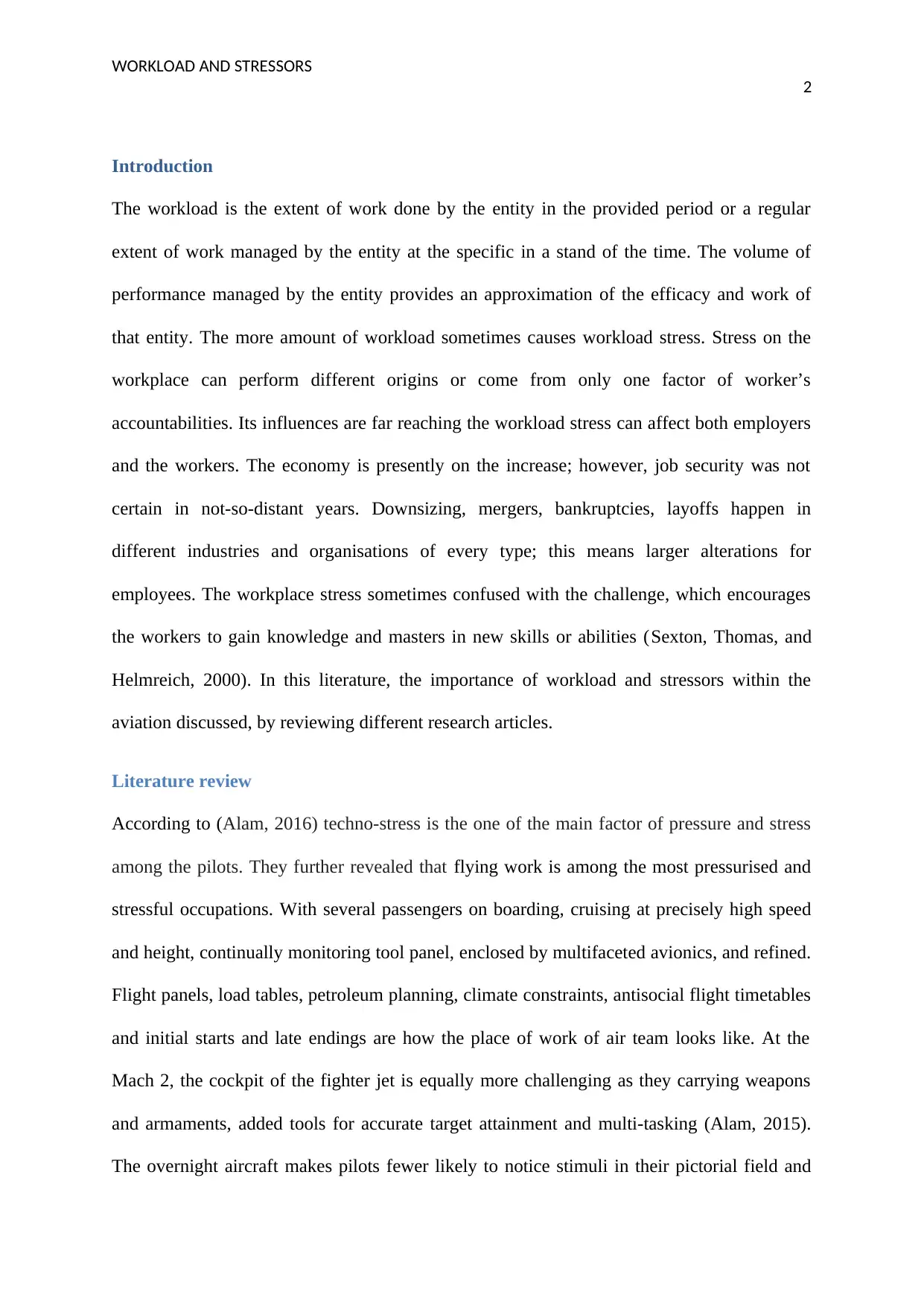
WORKLOAD AND STRESSORS
2
Introduction
The workload is the extent of work done by the entity in the provided period or a regular
extent of work managed by the entity at the specific in a stand of the time. The volume of
performance managed by the entity provides an approximation of the efficacy and work of
that entity. The more amount of workload sometimes causes workload stress. Stress on the
workplace can perform different origins or come from only one factor of worker’s
accountabilities. Its influences are far reaching the workload stress can affect both employers
and the workers. The economy is presently on the increase; however, job security was not
certain in not-so-distant years. Downsizing, mergers, bankruptcies, layoffs happen in
different industries and organisations of every type; this means larger alterations for
employees. The workplace stress sometimes confused with the challenge, which encourages
the workers to gain knowledge and masters in new skills or abilities (Sexton, Thomas, and
Helmreich, 2000). In this literature, the importance of workload and stressors within the
aviation discussed, by reviewing different research articles.
Literature review
According to (Alam, 2016) techno-stress is the one of the main factor of pressure and stress
among the pilots. They further revealed that flying work is among the most pressurised and
stressful occupations. With several passengers on boarding, cruising at precisely high speed
and height, continually monitoring tool panel, enclosed by multifaceted avionics, and refined.
Flight panels, load tables, petroleum planning, climate constraints, antisocial flight timetables
and initial starts and late endings are how the place of work of air team looks like. At the
Mach 2, the cockpit of the fighter jet is equally more challenging as they carrying weapons
and armaments, added tools for accurate target attainment and multi-tasking (Alam, 2015).
The overnight aircraft makes pilots fewer likely to notice stimuli in their pictorial field and
2
Introduction
The workload is the extent of work done by the entity in the provided period or a regular
extent of work managed by the entity at the specific in a stand of the time. The volume of
performance managed by the entity provides an approximation of the efficacy and work of
that entity. The more amount of workload sometimes causes workload stress. Stress on the
workplace can perform different origins or come from only one factor of worker’s
accountabilities. Its influences are far reaching the workload stress can affect both employers
and the workers. The economy is presently on the increase; however, job security was not
certain in not-so-distant years. Downsizing, mergers, bankruptcies, layoffs happen in
different industries and organisations of every type; this means larger alterations for
employees. The workplace stress sometimes confused with the challenge, which encourages
the workers to gain knowledge and masters in new skills or abilities (Sexton, Thomas, and
Helmreich, 2000). In this literature, the importance of workload and stressors within the
aviation discussed, by reviewing different research articles.
Literature review
According to (Alam, 2016) techno-stress is the one of the main factor of pressure and stress
among the pilots. They further revealed that flying work is among the most pressurised and
stressful occupations. With several passengers on boarding, cruising at precisely high speed
and height, continually monitoring tool panel, enclosed by multifaceted avionics, and refined.
Flight panels, load tables, petroleum planning, climate constraints, antisocial flight timetables
and initial starts and late endings are how the place of work of air team looks like. At the
Mach 2, the cockpit of the fighter jet is equally more challenging as they carrying weapons
and armaments, added tools for accurate target attainment and multi-tasking (Alam, 2015).
The overnight aircraft makes pilots fewer likely to notice stimuli in their pictorial field and
⊘ This is a preview!⊘
Do you want full access?
Subscribe today to unlock all pages.

Trusted by 1+ million students worldwide
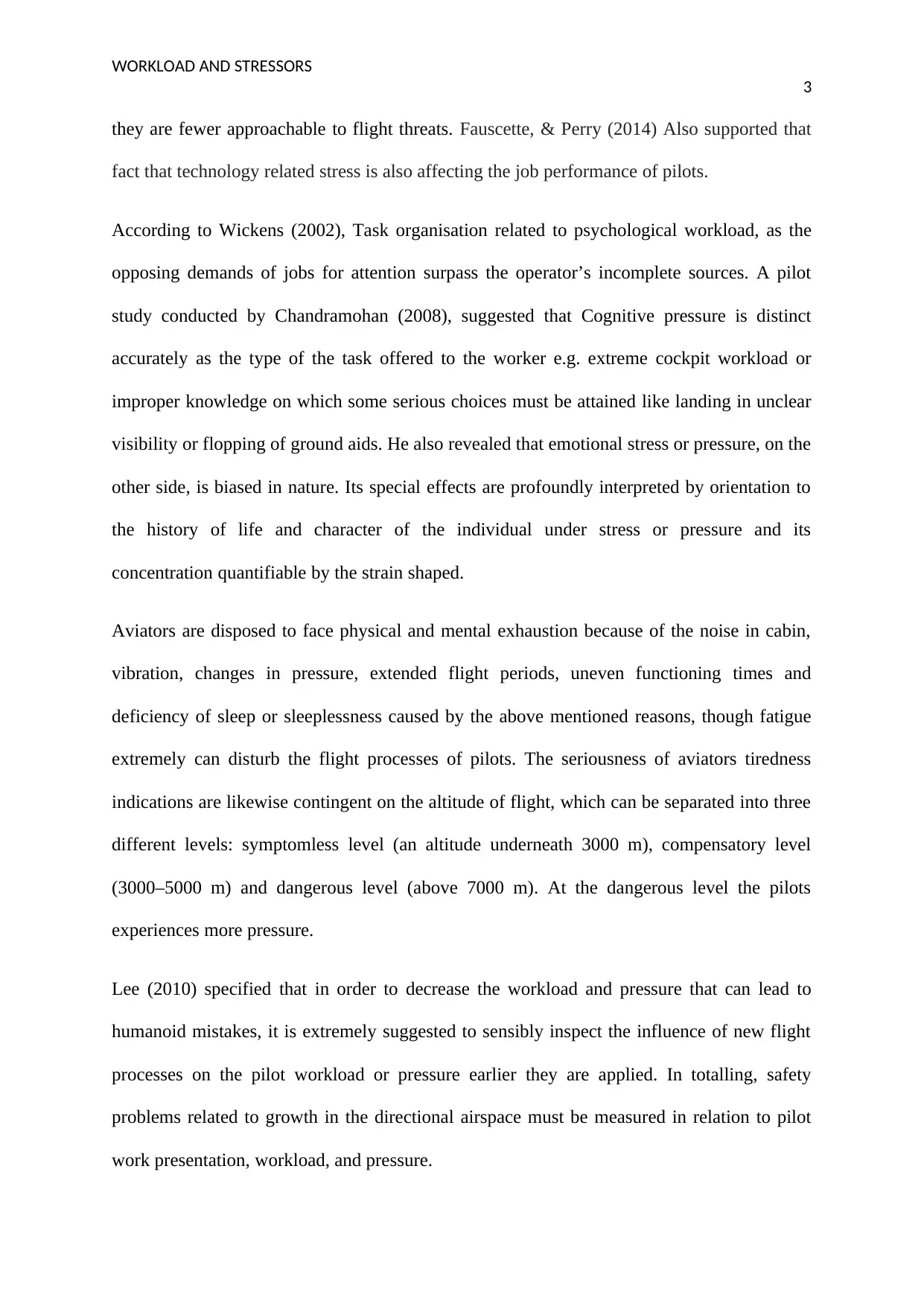
WORKLOAD AND STRESSORS
3
they are fewer approachable to flight threats. Fauscette, & Perry (2014) Also supported that
fact that technology related stress is also affecting the job performance of pilots.
According to Wickens (2002), Task organisation related to psychological workload, as the
opposing demands of jobs for attention surpass the operator’s incomplete sources. A pilot
study conducted by Chandramohan (2008), suggested that Cognitive pressure is distinct
accurately as the type of the task offered to the worker e.g. extreme cockpit workload or
improper knowledge on which some serious choices must be attained like landing in unclear
visibility or flopping of ground aids. He also revealed that emotional stress or pressure, on the
other side, is biased in nature. Its special effects are profoundly interpreted by orientation to
the history of life and character of the individual under stress or pressure and its
concentration quantifiable by the strain shaped.
Aviators are disposed to face physical and mental exhaustion because of the noise in cabin,
vibration, changes in pressure, extended flight periods, uneven functioning times and
deficiency of sleep or sleeplessness caused by the above mentioned reasons, though fatigue
extremely can disturb the flight processes of pilots. The seriousness of aviators tiredness
indications are likewise contingent on the altitude of flight, which can be separated into three
different levels: symptomless level (an altitude underneath 3000 m), compensatory level
(3000–5000 m) and dangerous level (above 7000 m). At the dangerous level the pilots
experiences more pressure.
Lee (2010) specified that in order to decrease the workload and pressure that can lead to
humanoid mistakes, it is extremely suggested to sensibly inspect the influence of new flight
processes on the pilot workload or pressure earlier they are applied. In totalling, safety
problems related to growth in the directional airspace must be measured in relation to pilot
work presentation, workload, and pressure.
3
they are fewer approachable to flight threats. Fauscette, & Perry (2014) Also supported that
fact that technology related stress is also affecting the job performance of pilots.
According to Wickens (2002), Task organisation related to psychological workload, as the
opposing demands of jobs for attention surpass the operator’s incomplete sources. A pilot
study conducted by Chandramohan (2008), suggested that Cognitive pressure is distinct
accurately as the type of the task offered to the worker e.g. extreme cockpit workload or
improper knowledge on which some serious choices must be attained like landing in unclear
visibility or flopping of ground aids. He also revealed that emotional stress or pressure, on the
other side, is biased in nature. Its special effects are profoundly interpreted by orientation to
the history of life and character of the individual under stress or pressure and its
concentration quantifiable by the strain shaped.
Aviators are disposed to face physical and mental exhaustion because of the noise in cabin,
vibration, changes in pressure, extended flight periods, uneven functioning times and
deficiency of sleep or sleeplessness caused by the above mentioned reasons, though fatigue
extremely can disturb the flight processes of pilots. The seriousness of aviators tiredness
indications are likewise contingent on the altitude of flight, which can be separated into three
different levels: symptomless level (an altitude underneath 3000 m), compensatory level
(3000–5000 m) and dangerous level (above 7000 m). At the dangerous level the pilots
experiences more pressure.
Lee (2010) specified that in order to decrease the workload and pressure that can lead to
humanoid mistakes, it is extremely suggested to sensibly inspect the influence of new flight
processes on the pilot workload or pressure earlier they are applied. In totalling, safety
problems related to growth in the directional airspace must be measured in relation to pilot
work presentation, workload, and pressure.
Paraphrase This Document
Need a fresh take? Get an instant paraphrase of this document with our AI Paraphraser

WORKLOAD AND STRESSORS
4
According to Wei, Zhuang, Wanyan, Zhang, and Liu (2014) Mental Workload is the issue
that has continuously been considered as a significant factor that affects pilots’ functioning or
performance. Because under extreme mental load, the aviators might exhibit postponed
reaction to certain of the incoming important information; though under insufficient
psychological workload, the aviators might lack vigilant consciousness or even miss certain
unusual flight information. Airplane flight deck show interface, as the essential human
computer communication of providing information related to flight to aviators, its design
must provide suitable mental workload, or else may extremely affect flight protection (Wei et
al., 2014).
Stress in aviation commerce is a mutual phenomenon comprised of three
sources: bodily stressors, mental stressors, and environmental stressors. Expert pilots may
face stress in the flight, during work- associated events on the ground, and during individual
time due to the effect of their profession. The airline pilot might be an exceptionally stressful
job because of the workload, duties, and protection of the thousands of travellers they
transport everywhere in the world (Sexton, Thomas, and Helmreich, 2000). Long-lasting
levels of stress can harmfully influence one's wellbeing, work performance, and mental
functioning. Being unprotected to stress does not continuously negatively affect humans as it
can also motivate persons to progress and help them familiarise to a novel environment.
Disastrous accidents twitch to occur when the pilots are under extreme stress, as it intensely
affects their physical, expressive, and mental situations (Sexton, Thomas, and Helmreich,
2000).
The role high workload and role clash have important positive effects on work stress.
Additionally, both shift job and its interloping with non‐work actions expressively
elevated the effects of role overwork on job pressure. Results also disclosed that decision
4
According to Wei, Zhuang, Wanyan, Zhang, and Liu (2014) Mental Workload is the issue
that has continuously been considered as a significant factor that affects pilots’ functioning or
performance. Because under extreme mental load, the aviators might exhibit postponed
reaction to certain of the incoming important information; though under insufficient
psychological workload, the aviators might lack vigilant consciousness or even miss certain
unusual flight information. Airplane flight deck show interface, as the essential human
computer communication of providing information related to flight to aviators, its design
must provide suitable mental workload, or else may extremely affect flight protection (Wei et
al., 2014).
Stress in aviation commerce is a mutual phenomenon comprised of three
sources: bodily stressors, mental stressors, and environmental stressors. Expert pilots may
face stress in the flight, during work- associated events on the ground, and during individual
time due to the effect of their profession. The airline pilot might be an exceptionally stressful
job because of the workload, duties, and protection of the thousands of travellers they
transport everywhere in the world (Sexton, Thomas, and Helmreich, 2000). Long-lasting
levels of stress can harmfully influence one's wellbeing, work performance, and mental
functioning. Being unprotected to stress does not continuously negatively affect humans as it
can also motivate persons to progress and help them familiarise to a novel environment.
Disastrous accidents twitch to occur when the pilots are under extreme stress, as it intensely
affects their physical, expressive, and mental situations (Sexton, Thomas, and Helmreich,
2000).
The role high workload and role clash have important positive effects on work stress.
Additionally, both shift job and its interloping with non‐work actions expressively
elevated the effects of role overwork on job pressure. Results also disclosed that decision

WORKLOAD AND STRESSORS
5
opportunity mitigated the harmful effect of role overwork on job pressure for staffs
working on a stable shift, but not for workers functioning on rotational shift. They also
recommended that aviation directors require focusing not only on choice freedom but
also on work and organisational scheme to mitigate the influence of job burdens on
stress. Though decision freedom works to comfort demands among the people who work
on permanent shifts, it does not act in a similar way for those functioning on rotational
shifts (Fornette, Bardel, Lefrançois, Fradin, Massioui, and Amalberti, 2012).
A report published by Fothergill and Neal (2008) also supported that fact that workload
stressors have an important effect of the worker's output and state that work related
pressure does disturb conflict determination performance. Stage or level of workload can
specifically affect conflict determination choices in circumstances where the optimum
solution was extra compound and enforced a higher controlling burden on the organiser.
Accurately, in participants with little workload were additionally probable to accept
approaches that were competent for the airplane; while in great workload, organisers were
probable to select convenient, but less effective, solutions. The results disclosed how
workload disturbs decision construction in this atmosphere and have broader associations for
effectiveness against protection trade-offs in related, vigorous areas.
A quantifiable evaluation on workload and stressors has been prepared by Mazur et al. (2012)
in medical research, recommended that Workload state and bases of stressors have been
concerned as sources of mistake in multiple situations. They also revealed that disturbances,
technical aspects (mainly software faults), and collaboration factors (largely collaboration
among group members) signify the most recurrent causes of stressors. Likewise, the great
number of environmental stressors for the radiation oncologists might be the outcome of
certain of the office layout at their hospital. For instance, ample of the medical computer
5
opportunity mitigated the harmful effect of role overwork on job pressure for staffs
working on a stable shift, but not for workers functioning on rotational shift. They also
recommended that aviation directors require focusing not only on choice freedom but
also on work and organisational scheme to mitigate the influence of job burdens on
stress. Though decision freedom works to comfort demands among the people who work
on permanent shifts, it does not act in a similar way for those functioning on rotational
shifts (Fornette, Bardel, Lefrançois, Fradin, Massioui, and Amalberti, 2012).
A report published by Fothergill and Neal (2008) also supported that fact that workload
stressors have an important effect of the worker's output and state that work related
pressure does disturb conflict determination performance. Stage or level of workload can
specifically affect conflict determination choices in circumstances where the optimum
solution was extra compound and enforced a higher controlling burden on the organiser.
Accurately, in participants with little workload were additionally probable to accept
approaches that were competent for the airplane; while in great workload, organisers were
probable to select convenient, but less effective, solutions. The results disclosed how
workload disturbs decision construction in this atmosphere and have broader associations for
effectiveness against protection trade-offs in related, vigorous areas.
A quantifiable evaluation on workload and stressors has been prepared by Mazur et al. (2012)
in medical research, recommended that Workload state and bases of stressors have been
concerned as sources of mistake in multiple situations. They also revealed that disturbances,
technical aspects (mainly software faults), and collaboration factors (largely collaboration
among group members) signify the most recurrent causes of stressors. Likewise, the great
number of environmental stressors for the radiation oncologists might be the outcome of
certain of the office layout at their hospital. For instance, ample of the medical computer
⊘ This is a preview!⊘
Do you want full access?
Subscribe today to unlock all pages.

Trusted by 1+ million students worldwide
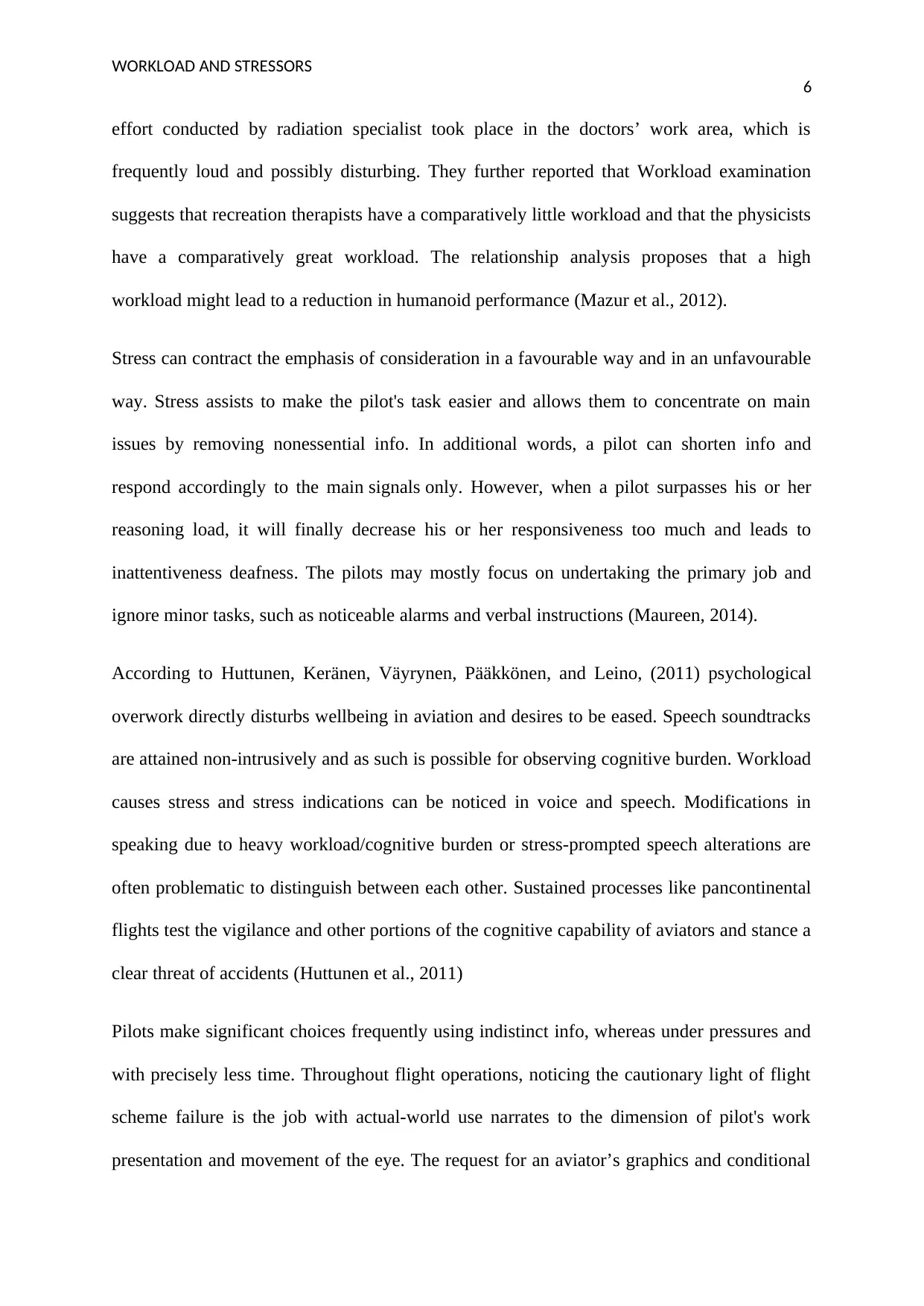
WORKLOAD AND STRESSORS
6
effort conducted by radiation specialist took place in the doctors’ work area, which is
frequently loud and possibly disturbing. They further reported that Workload examination
suggests that recreation therapists have a comparatively little workload and that the physicists
have a comparatively great workload. The relationship analysis proposes that a high
workload might lead to a reduction in humanoid performance (Mazur et al., 2012).
Stress can contract the emphasis of consideration in a favourable way and in an unfavourable
way. Stress assists to make the pilot's task easier and allows them to concentrate on main
issues by removing nonessential info. In additional words, a pilot can shorten info and
respond accordingly to the main signals only. However, when a pilot surpasses his or her
reasoning load, it will finally decrease his or her responsiveness too much and leads to
inattentiveness deafness. The pilots may mostly focus on undertaking the primary job and
ignore minor tasks, such as noticeable alarms and verbal instructions (Maureen, 2014).
According to Huttunen, Keränen, Väyrynen, Pääkkönen, and Leino, (2011) psychological
overwork directly disturbs wellbeing in aviation and desires to be eased. Speech soundtracks
are attained non-intrusively and as such is possible for observing cognitive burden. Workload
causes stress and stress indications can be noticed in voice and speech. Modifications in
speaking due to heavy workload/cognitive burden or stress-prompted speech alterations are
often problematic to distinguish between each other. Sustained processes like pancontinental
flights test the vigilance and other portions of the cognitive capability of aviators and stance a
clear threat of accidents (Huttunen et al., 2011)
Pilots make significant choices frequently using indistinct info, whereas under pressures and
with precisely less time. Throughout flight operations, noticing the cautionary light of flight
scheme failure is the job with actual-world use narrates to the dimension of pilot's work
presentation and movement of the eye. The request for an aviator’s graphics and conditional
6
effort conducted by radiation specialist took place in the doctors’ work area, which is
frequently loud and possibly disturbing. They further reported that Workload examination
suggests that recreation therapists have a comparatively little workload and that the physicists
have a comparatively great workload. The relationship analysis proposes that a high
workload might lead to a reduction in humanoid performance (Mazur et al., 2012).
Stress can contract the emphasis of consideration in a favourable way and in an unfavourable
way. Stress assists to make the pilot's task easier and allows them to concentrate on main
issues by removing nonessential info. In additional words, a pilot can shorten info and
respond accordingly to the main signals only. However, when a pilot surpasses his or her
reasoning load, it will finally decrease his or her responsiveness too much and leads to
inattentiveness deafness. The pilots may mostly focus on undertaking the primary job and
ignore minor tasks, such as noticeable alarms and verbal instructions (Maureen, 2014).
According to Huttunen, Keränen, Väyrynen, Pääkkönen, and Leino, (2011) psychological
overwork directly disturbs wellbeing in aviation and desires to be eased. Speech soundtracks
are attained non-intrusively and as such is possible for observing cognitive burden. Workload
causes stress and stress indications can be noticed in voice and speech. Modifications in
speaking due to heavy workload/cognitive burden or stress-prompted speech alterations are
often problematic to distinguish between each other. Sustained processes like pancontinental
flights test the vigilance and other portions of the cognitive capability of aviators and stance a
clear threat of accidents (Huttunen et al., 2011)
Pilots make significant choices frequently using indistinct info, whereas under pressures and
with precisely less time. Throughout flight operations, noticing the cautionary light of flight
scheme failure is the job with actual-world use narrates to the dimension of pilot's work
presentation and movement of the eye. The request for an aviator’s graphics and conditional
Paraphrase This Document
Need a fresh take? Get an instant paraphrase of this document with our AI Paraphraser
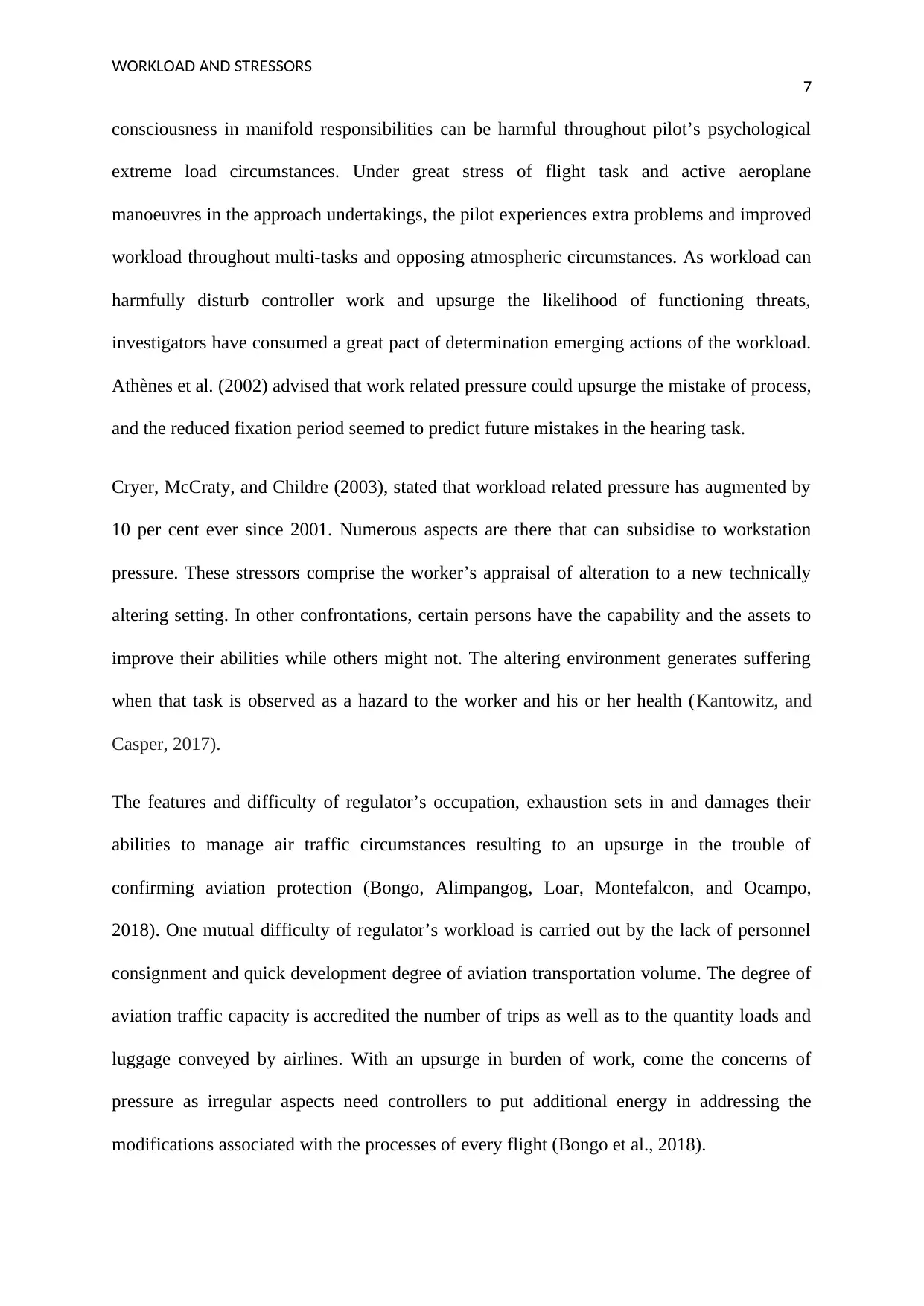
WORKLOAD AND STRESSORS
7
consciousness in manifold responsibilities can be harmful throughout pilot’s psychological
extreme load circumstances. Under great stress of flight task and active aeroplane
manoeuvres in the approach undertakings, the pilot experiences extra problems and improved
workload throughout multi-tasks and opposing atmospheric circumstances. As workload can
harmfully disturb controller work and upsurge the likelihood of functioning threats,
investigators have consumed a great pact of determination emerging actions of the workload.
Athènes et al. (2002) advised that work related pressure could upsurge the mistake of process,
and the reduced fixation period seemed to predict future mistakes in the hearing task.
Cryer, McCraty, and Childre (2003), stated that workload related pressure has augmented by
10 per cent ever since 2001. Numerous aspects are there that can subsidise to workstation
pressure. These stressors comprise the worker’s appraisal of alteration to a new technically
altering setting. In other confrontations, certain persons have the capability and the assets to
improve their abilities while others might not. The altering environment generates suffering
when that task is observed as a hazard to the worker and his or her health (Kantowitz, and
Casper, 2017).
The features and difficulty of regulator’s occupation, exhaustion sets in and damages their
abilities to manage air traffic circumstances resulting to an upsurge in the trouble of
confirming aviation protection (Bongo, Alimpangog, Loar, Montefalcon, and Ocampo,
2018). One mutual difficulty of regulator’s workload is carried out by the lack of personnel
consignment and quick development degree of aviation transportation volume. The degree of
aviation traffic capacity is accredited the number of trips as well as to the quantity loads and
luggage conveyed by airlines. With an upsurge in burden of work, come the concerns of
pressure as irregular aspects need controllers to put additional energy in addressing the
modifications associated with the processes of every flight (Bongo et al., 2018).
7
consciousness in manifold responsibilities can be harmful throughout pilot’s psychological
extreme load circumstances. Under great stress of flight task and active aeroplane
manoeuvres in the approach undertakings, the pilot experiences extra problems and improved
workload throughout multi-tasks and opposing atmospheric circumstances. As workload can
harmfully disturb controller work and upsurge the likelihood of functioning threats,
investigators have consumed a great pact of determination emerging actions of the workload.
Athènes et al. (2002) advised that work related pressure could upsurge the mistake of process,
and the reduced fixation period seemed to predict future mistakes in the hearing task.
Cryer, McCraty, and Childre (2003), stated that workload related pressure has augmented by
10 per cent ever since 2001. Numerous aspects are there that can subsidise to workstation
pressure. These stressors comprise the worker’s appraisal of alteration to a new technically
altering setting. In other confrontations, certain persons have the capability and the assets to
improve their abilities while others might not. The altering environment generates suffering
when that task is observed as a hazard to the worker and his or her health (Kantowitz, and
Casper, 2017).
The features and difficulty of regulator’s occupation, exhaustion sets in and damages their
abilities to manage air traffic circumstances resulting to an upsurge in the trouble of
confirming aviation protection (Bongo, Alimpangog, Loar, Montefalcon, and Ocampo,
2018). One mutual difficulty of regulator’s workload is carried out by the lack of personnel
consignment and quick development degree of aviation transportation volume. The degree of
aviation traffic capacity is accredited the number of trips as well as to the quantity loads and
luggage conveyed by airlines. With an upsurge in burden of work, come the concerns of
pressure as irregular aspects need controllers to put additional energy in addressing the
modifications associated with the processes of every flight (Bongo et al., 2018).
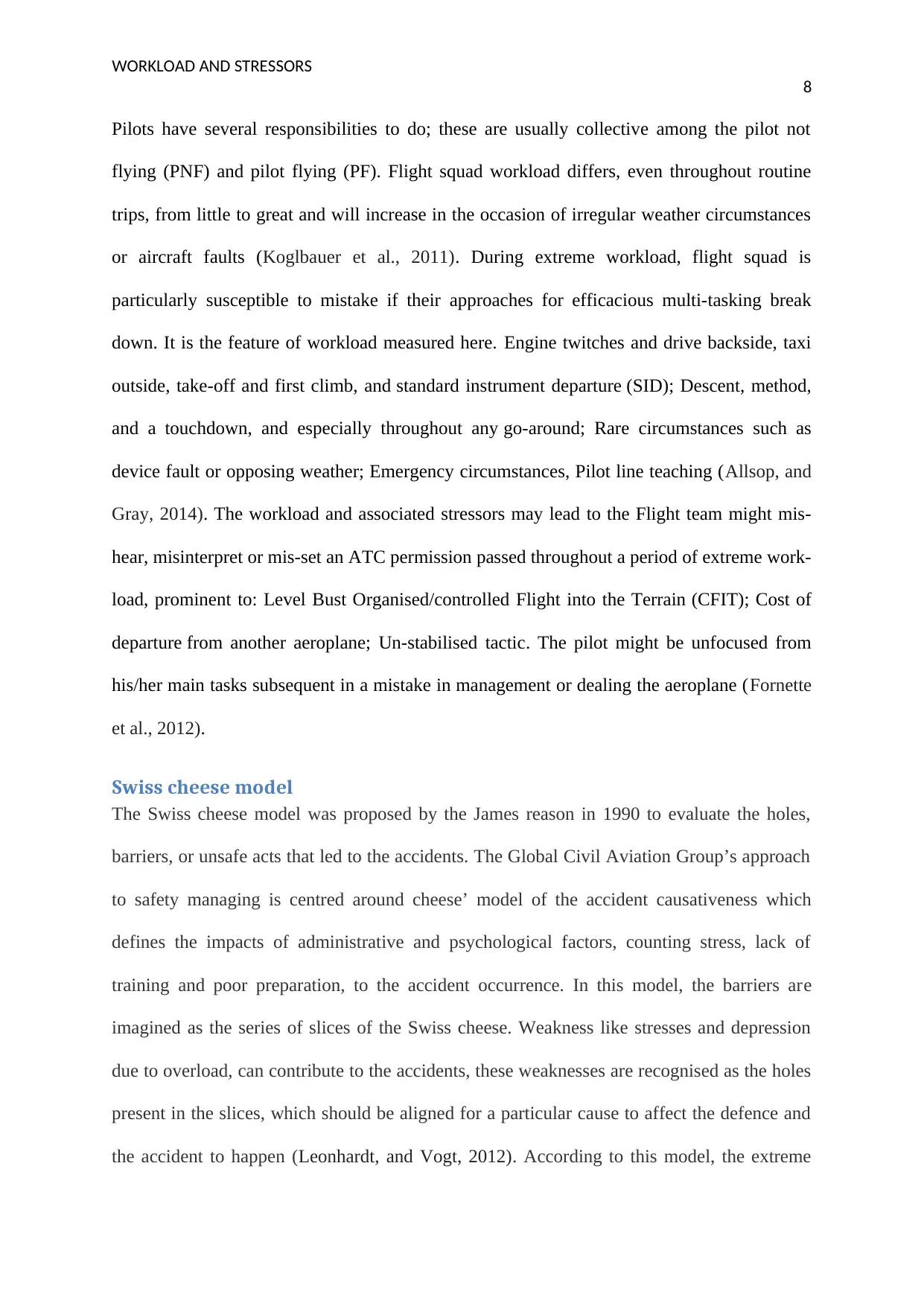
WORKLOAD AND STRESSORS
8
Pilots have several responsibilities to do; these are usually collective among the pilot not
flying (PNF) and pilot flying (PF). Flight squad workload differs, even throughout routine
trips, from little to great and will increase in the occasion of irregular weather circumstances
or aircraft faults (Koglbauer et al., 2011). During extreme workload, flight squad is
particularly susceptible to mistake if their approaches for efficacious multi-tasking break
down. It is the feature of workload measured here. Engine twitches and drive backside, taxi
outside, take-off and first climb, and standard instrument departure (SID); Descent, method,
and a touchdown, and especially throughout any go-around; Rare circumstances such as
device fault or opposing weather; Emergency circumstances, Pilot line teaching (Allsop, and
Gray, 2014). The workload and associated stressors may lead to the Flight team might mis-
hear, misinterpret or mis-set an ATC permission passed throughout a period of extreme work-
load, prominent to: Level Bust Organised/controlled Flight into the Terrain (CFIT); Cost of
departure from another aeroplane; Un-stabilised tactic. The pilot might be unfocused from
his/her main tasks subsequent in a mistake in management or dealing the aeroplane (Fornette
et al., 2012).
Swiss cheese model
The Swiss cheese model was proposed by the James reason in 1990 to evaluate the holes,
barriers, or unsafe acts that led to the accidents. The Global Civil Aviation Group’s approach
to safety managing is centred around cheese’ model of the accident causativeness which
defines the impacts of administrative and psychological factors, counting stress, lack of
training and poor preparation, to the accident occurrence. In this model, the barriers are
imagined as the series of slices of the Swiss cheese. Weakness like stresses and depression
due to overload, can contribute to the accidents, these weaknesses are recognised as the holes
present in the slices, which should be aligned for a particular cause to affect the defence and
the accident to happen (Leonhardt, and Vogt, 2012). According to this model, the extreme
8
Pilots have several responsibilities to do; these are usually collective among the pilot not
flying (PNF) and pilot flying (PF). Flight squad workload differs, even throughout routine
trips, from little to great and will increase in the occasion of irregular weather circumstances
or aircraft faults (Koglbauer et al., 2011). During extreme workload, flight squad is
particularly susceptible to mistake if their approaches for efficacious multi-tasking break
down. It is the feature of workload measured here. Engine twitches and drive backside, taxi
outside, take-off and first climb, and standard instrument departure (SID); Descent, method,
and a touchdown, and especially throughout any go-around; Rare circumstances such as
device fault or opposing weather; Emergency circumstances, Pilot line teaching (Allsop, and
Gray, 2014). The workload and associated stressors may lead to the Flight team might mis-
hear, misinterpret or mis-set an ATC permission passed throughout a period of extreme work-
load, prominent to: Level Bust Organised/controlled Flight into the Terrain (CFIT); Cost of
departure from another aeroplane; Un-stabilised tactic. The pilot might be unfocused from
his/her main tasks subsequent in a mistake in management or dealing the aeroplane (Fornette
et al., 2012).
Swiss cheese model
The Swiss cheese model was proposed by the James reason in 1990 to evaluate the holes,
barriers, or unsafe acts that led to the accidents. The Global Civil Aviation Group’s approach
to safety managing is centred around cheese’ model of the accident causativeness which
defines the impacts of administrative and psychological factors, counting stress, lack of
training and poor preparation, to the accident occurrence. In this model, the barriers are
imagined as the series of slices of the Swiss cheese. Weakness like stresses and depression
due to overload, can contribute to the accidents, these weaknesses are recognised as the holes
present in the slices, which should be aligned for a particular cause to affect the defence and
the accident to happen (Leonhardt, and Vogt, 2012). According to this model, the extreme
⊘ This is a preview!⊘
Do you want full access?
Subscribe today to unlock all pages.

Trusted by 1+ million students worldwide
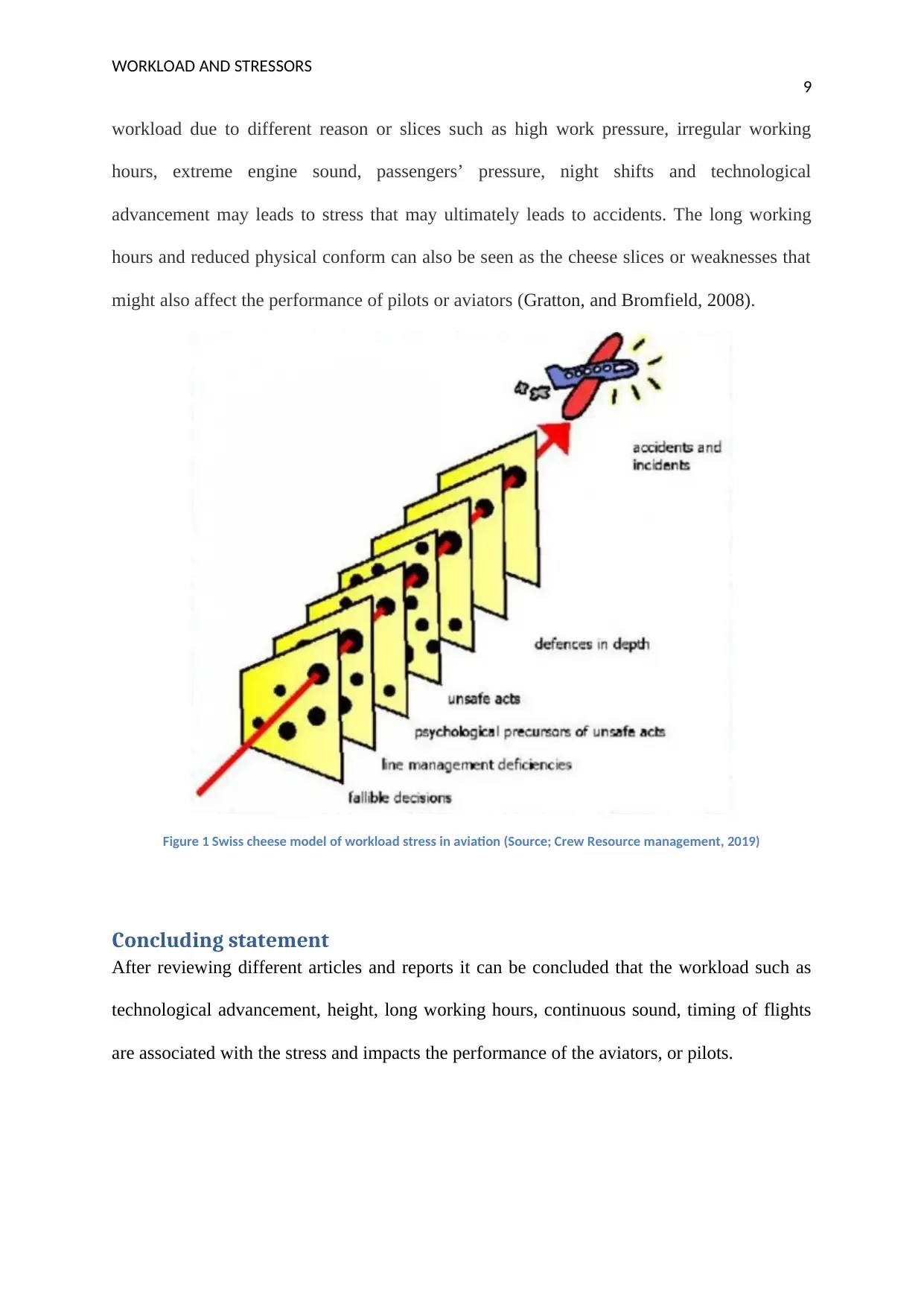
WORKLOAD AND STRESSORS
9
workload due to different reason or slices such as high work pressure, irregular working
hours, extreme engine sound, passengers’ pressure, night shifts and technological
advancement may leads to stress that may ultimately leads to accidents. The long working
hours and reduced physical conform can also be seen as the cheese slices or weaknesses that
might also affect the performance of pilots or aviators (Gratton, and Bromfield, 2008).
Figure 1 Swiss cheese model of workload stress in aviation (Source; Crew Resource management, 2019)
Concluding statement
After reviewing different articles and reports it can be concluded that the workload such as
technological advancement, height, long working hours, continuous sound, timing of flights
are associated with the stress and impacts the performance of the aviators, or pilots.
9
workload due to different reason or slices such as high work pressure, irregular working
hours, extreme engine sound, passengers’ pressure, night shifts and technological
advancement may leads to stress that may ultimately leads to accidents. The long working
hours and reduced physical conform can also be seen as the cheese slices or weaknesses that
might also affect the performance of pilots or aviators (Gratton, and Bromfield, 2008).
Figure 1 Swiss cheese model of workload stress in aviation (Source; Crew Resource management, 2019)
Concluding statement
After reviewing different articles and reports it can be concluded that the workload such as
technological advancement, height, long working hours, continuous sound, timing of flights
are associated with the stress and impacts the performance of the aviators, or pilots.
Paraphrase This Document
Need a fresh take? Get an instant paraphrase of this document with our AI Paraphraser

WORKLOAD AND STRESSORS
10
References
Alam, M.A., 2016. Techno-stress and productivity: Survey evidence from the aviation
industry. Journal of Air Transport Management, 50, pp.62-70.
Allsop, J., and Gray, R., 2014. Flying under pressure: Effects of anxiety on attention and gaze
behavior in aviation. Journal of Applied Research in Memory and Cognition, 3(2), pp.63-71.
Athènes, S., Averty, P., Puechmorel, S., Delahaye, D., and Collet, C. 2002. ATC complexity
and controller workload: Trying to bridge the gap
Bongo, M.F., Alimpangog, K.M.S., Loar, J.F., Montefalcon, J.A. and Ocampo, L.A., 2018.
An application of DEMATEL-ANP and PROMETHEE II approach for air traffic controllers’
workload stress problem: A case of Mactan Civil Aviation Authority of the
Philippines. Journal of Air Transport Management, 68, pp.198-213.
Chandramohan, V., 2008. Stressors and stress coping strategies among Civil pilots: A pilot
study. Ind J Aerospace Med, 52, p.2.
Crew Resource management. 2019. Design versus operator induced errors [online].
Available from: https://www.crewresourcemanagement.net/human-error-reliability-and-error-
management/design-versus-operator-induced-errors [Accessed 08 March 2019].
Cryer, B., McCraty, R., and Childre, D. 2003. Pull the plug on stress. Harvard Business
Review, 81(7), 102-7, 118.
Fauscette, M., & Perry, R. 2014. Simplifying IT to drive better business outcomes and
improved ROI: Introducing the IT complexity index. IDC.
10
References
Alam, M.A., 2016. Techno-stress and productivity: Survey evidence from the aviation
industry. Journal of Air Transport Management, 50, pp.62-70.
Allsop, J., and Gray, R., 2014. Flying under pressure: Effects of anxiety on attention and gaze
behavior in aviation. Journal of Applied Research in Memory and Cognition, 3(2), pp.63-71.
Athènes, S., Averty, P., Puechmorel, S., Delahaye, D., and Collet, C. 2002. ATC complexity
and controller workload: Trying to bridge the gap
Bongo, M.F., Alimpangog, K.M.S., Loar, J.F., Montefalcon, J.A. and Ocampo, L.A., 2018.
An application of DEMATEL-ANP and PROMETHEE II approach for air traffic controllers’
workload stress problem: A case of Mactan Civil Aviation Authority of the
Philippines. Journal of Air Transport Management, 68, pp.198-213.
Chandramohan, V., 2008. Stressors and stress coping strategies among Civil pilots: A pilot
study. Ind J Aerospace Med, 52, p.2.
Crew Resource management. 2019. Design versus operator induced errors [online].
Available from: https://www.crewresourcemanagement.net/human-error-reliability-and-error-
management/design-versus-operator-induced-errors [Accessed 08 March 2019].
Cryer, B., McCraty, R., and Childre, D. 2003. Pull the plug on stress. Harvard Business
Review, 81(7), 102-7, 118.
Fauscette, M., & Perry, R. 2014. Simplifying IT to drive better business outcomes and
improved ROI: Introducing the IT complexity index. IDC.

WORKLOAD AND STRESSORS
11
Fornette, M.P., Bardel, M.H., Lefrançois, C., Fradin, J., Massioui, F.E. and Amalberti, R.,
2012. Cognitive-adaptation training for improving performance and stress management of air
force pilots. The International Journal of Aviation Psychology, 22(3), pp.203-223.
Fothergill, S. and Neal, A., 2008,. The effect of workload on conflict decision making
strategies in air traffic control. In Proceedings of the human factors and ergonomics society
annual meeting (Vol. 52, No. 1, pp. 39-43). Sage CA: Los Angeles, CA: Sage Publications.
Gratton, G.B. and Bromfield, M.A., 2008. Aspects of general aviation flight safety research
Huttunen, K., Keränen, H., Väyrynen, E., Pääkkönen, R., and Leino, T., 2011. Effect of
cognitive load on speech prosody in aviation: Evidence from military simulator
flights. Applied Ergonomics, 42(2), pp.348-357.
Kantowitz, B.H., and Casper, P.A., 2017. The human workload in aviation. In Human Error
in Aviation (pp. 123-153). Routledge.
Koglbauer, I., Kallus, K.W., Braunstingl, R. and Boucsein, W., 2011. Recovery training in
simulator improves performance and psychophysiological state of pilots during simulated and
real visual flight rules flight. The international journal of aviation psychology, 21(4), pp.307-
324.
Lee, K., 2010. Effects of flight factors on pilot performance, workload, and stress at final
approach to landing phase of flight.
Leonhardt, J. and Vogt, M.J. eds., 2012. Critical incident stress management in aviation.
Ashgate Publishing, Ltd..
11
Fornette, M.P., Bardel, M.H., Lefrançois, C., Fradin, J., Massioui, F.E. and Amalberti, R.,
2012. Cognitive-adaptation training for improving performance and stress management of air
force pilots. The International Journal of Aviation Psychology, 22(3), pp.203-223.
Fothergill, S. and Neal, A., 2008,. The effect of workload on conflict decision making
strategies in air traffic control. In Proceedings of the human factors and ergonomics society
annual meeting (Vol. 52, No. 1, pp. 39-43). Sage CA: Los Angeles, CA: Sage Publications.
Gratton, G.B. and Bromfield, M.A., 2008. Aspects of general aviation flight safety research
Huttunen, K., Keränen, H., Väyrynen, E., Pääkkönen, R., and Leino, T., 2011. Effect of
cognitive load on speech prosody in aviation: Evidence from military simulator
flights. Applied Ergonomics, 42(2), pp.348-357.
Kantowitz, B.H., and Casper, P.A., 2017. The human workload in aviation. In Human Error
in Aviation (pp. 123-153). Routledge.
Koglbauer, I., Kallus, K.W., Braunstingl, R. and Boucsein, W., 2011. Recovery training in
simulator improves performance and psychophysiological state of pilots during simulated and
real visual flight rules flight. The international journal of aviation psychology, 21(4), pp.307-
324.
Lee, K., 2010. Effects of flight factors on pilot performance, workload, and stress at final
approach to landing phase of flight.
Leonhardt, J. and Vogt, M.J. eds., 2012. Critical incident stress management in aviation.
Ashgate Publishing, Ltd..
⊘ This is a preview!⊘
Do you want full access?
Subscribe today to unlock all pages.

Trusted by 1+ million students worldwide
1 out of 13
Your All-in-One AI-Powered Toolkit for Academic Success.
+13062052269
info@desklib.com
Available 24*7 on WhatsApp / Email
![[object Object]](/_next/static/media/star-bottom.7253800d.svg)
Unlock your academic potential
Copyright © 2020–2025 A2Z Services. All Rights Reserved. Developed and managed by ZUCOL.